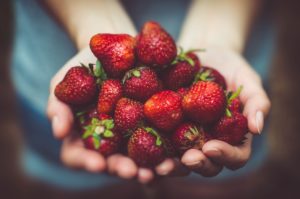The way garden centres promote strawberry plants and associated growing paraphernalia, anyone would think a complete amateur could produce a successful harvest of berries. Not so! In fact, most first-time strawberry gardeners are bitterly disappointed by plants that either fail to produce the goods, or deliver up tasteless woody fruit. Although you can’t do much to alter your climate (strawberries prefer warm days and cool nights), we have some micro-management techniques for you from a strawberry gardener in-the-know. Follow them closely and you may well be topping your pav with your own berries this Christmas!

Preparation
There are several basics that must be followed when growing strawberries, so let’s deal with these before we move onto the nitty-gritty. Firstly, strawberry beds should be prepared in late autumn, very early spring or, where conditions are mild, during winter. Dig well- rotted animal manure and chopped seaweed into the soil, and skip the lime. If your soil is already sweet (i.e. it has plenty of lime in it) acidify it by adding sulphur (ask at your garden centre for the best kind to use for a strawberry bed). Apply it as early in the preparation stage as possible. Cover the bed with a 2-3cm layer of mulch (pine needles are best but straw will suffice). Early spring is the time to plant.
Tried and true
When choosing seedling plants, don’t be lured into buying on the basis of fruit size. Many modern varieties of strawberry produce giant-fruit at the expense of flavour and texture so stick with tried and true old-time heirloom varieties for the best results. And be sure to purchase plants with a range of fruiting seasons so you’ll have berries throughout summer and autumn.
Making mounds
Strawberry plants won’t tolerate wet feet, and they will not thank you for letting them dry out. To help with drainage, plant your seedlings on ridges (15cm high and 20cm wide). Strawberry seedlings grown in planters and tubs will deliver fruit but if you want value for money, grow your plants in the garden.
Space is everything
A few well-spaced plants produce far more fruit than twice the number crowded together (trust us on this). Plant your seedlings no closer than 50cm apart. When the plants begin to send out runners (long stems which creep across the ground), snip these off. They’re the plant’s attempt to reproduce, and the new plants which form on the ends of the runners will only crowd your original seedlings.
Water watch
Strawberry plants plenty appreciate plenty of water prior to and during flowering but less as fruit is setting i.e. beginning to develop. However, at no stage should the ground be permitted to completely dry out. And while you can’t control rainfall, you can protect plants from receiving too much moisture by covering them with a cloche if necessary.
Infrequent feeding
Hold back on liquid feeding your plants. If you pour on nitrogen, your plants will produce masses of leaves at the expense of fruit. Give them a slurp of liquid manure once every 4 weeks and no more.
Lift the netting
We all know that strawberries need to be netted to keep birds at bay, but bees (one of the main pollinators of strawberry flowers) also need access to the blooms in order to pollinate them. While the mesh of strawberry netting is open enough to allow bees to pass through it to access the flowers, a greater number of bees will visit if the net is not in place – and the more bee visits, the more berries you will have. During the first flush of flowering (before the strawberries are ripe enough to attract the birds) lift the net for several hours during the middle of the day.









Join the Discussion
Type out your comment here:
You must be logged in to post a comment.